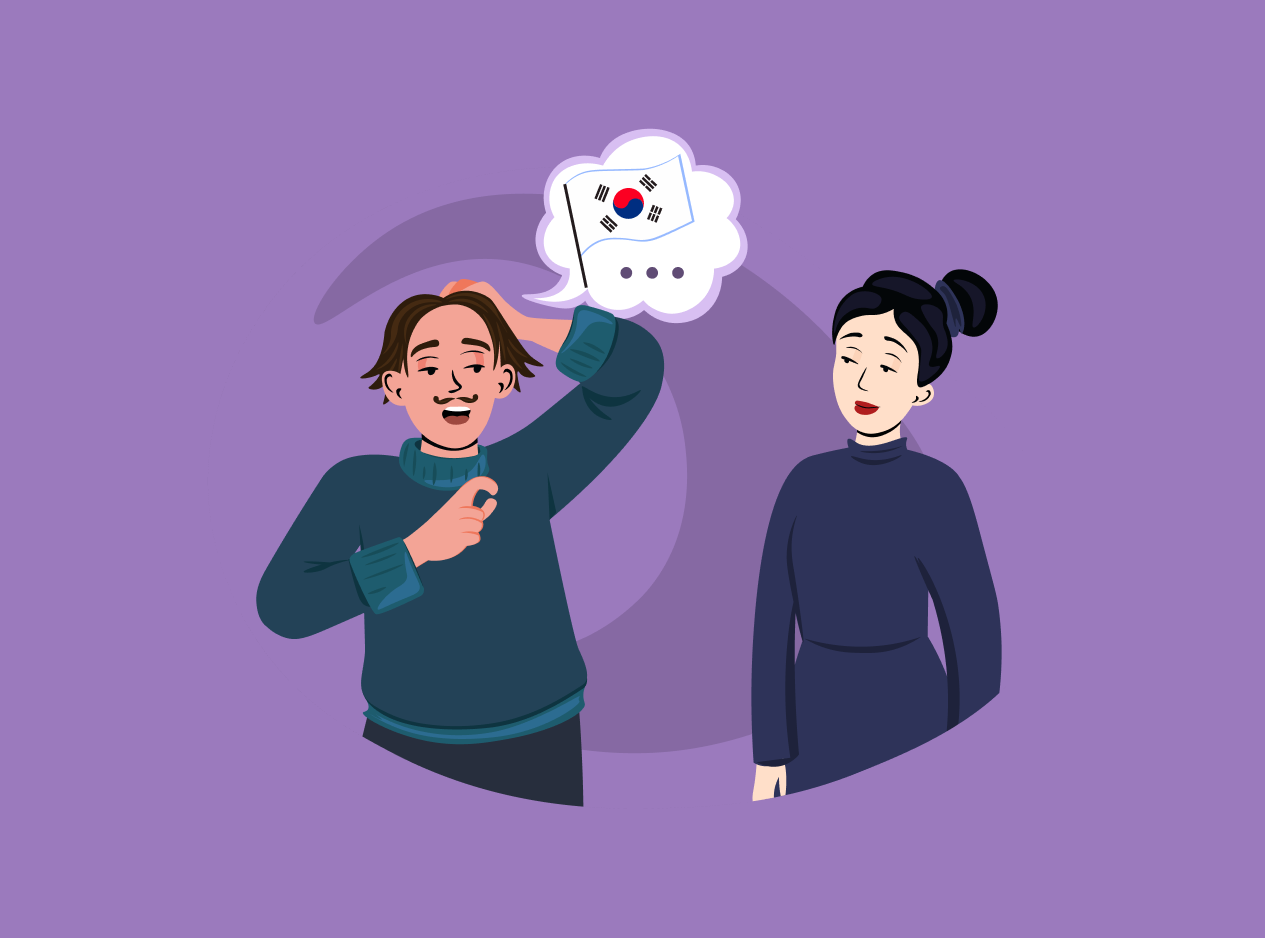Self Study Korean: Techniques and Resources for Mastering the Language

Contents
K-pop and K-dramas have put Korean culture on the global map. Yet, the language remains a mystery to many, shrouded in unique characters and intricate patterns. But don’t worry; you’re not alone in your quest to master Korean. This guide will provide instructions on how to learn Korean, breaking down this seemingly insurmountable task into bite-sized segments. We reveal strategies that make learning the language simpler, enjoyable, and manageable.
Creating a Comprehensive Learning Plan: The Best Way to Learn Korean
Diving into a new language can be daunting. Yet, a well-structured plan eases the process. By crafting a tailored strategy, you’ll speed up your learning and enhance retention. This section presents the core pillars for a successful Korean self-study journey.
Set Clear Goals
Learning a language like Korean necessitates clarity of purpose. Without a defined endgame, it’s easy to drift aimlessly through lessons, gaining bits and pieces without truly progressing. In the first step of your journey, you must outline what you seek to achieve.
Having a precise target – understanding your favorite K-pop lyrics or conversing confidently during a trip to Busan – grounds your efforts. When your goals resonate with personal interests or needs, motivation naturally surges.
Remember to revisit and adjust these goals as your linguistic journey evolves. Korean is a deep, rich language, and as you delve further, newer aspirations will undoubtedly emerge, ensuring sustained engagement and growth.
Decide on a Schedule
Establishing a rhythm in your learning journey is paramount. Without regularity, even the most enthusiastic learners can find themselves losing momentum. Structuring a consistent schedule ensures that Korean becomes an integral part of your daily life, paving the way for more effective assimilation.
Begin by analyzing your existing routine. Are there pockets of spare time that could be utilized better? Perhaps the 20 minutes of your morning coffee break or the half-hour before you wind down at night. These moments can transform into productive study sessions. Remember, it’s not about dedicating large chunks of time but about consistent, daily engagement.
Also, vary the content within your designated slots. Monday might be for vocabulary building, Tuesday for listening exercises, and Wednesday for conversation practice. Such variation keeps monotony at bay and targets different facets of language acquisition. These tips on learning Korean will surely keep the process engaging.
Choose Your Resources
The resources you select for your Korean study can impact your learning trajectory. The vast array of tools available today, both digital and physical, can be both a boon and a challenge.
First, gauge your learning style. Some individuals thrive with interactive tools, appreciating visual and auditory cues, while others might favor traditional textbooks, valuing the depth and structure they offer. It’s crucial to match resources to your preferences, ensuring consistent engagement. However, don’t limit yourself to one medium; a blend usually proves most beneficial.
For instance, the Korean language learning app by Promova offers interactive modules and exercises that make learning fun. It features varied content to help you grasp the nuances of Korean grammar, vocabulary, and other aspects, wrapping it all in a user-friendly interface.
The Foundation: Familiarizing Yourself with Hangul
If you have a question about how I can learn Korean by myself, the answer lies in starting with the basics: Hangul. It is the language’s alphabet system, comprising 14 consonants and ten vowels. Unlike many scripts, which might take months or even years to grasp fully, Hangul stands out with its logical and scientific design. Its key features include the following:
- Featural System. Each character represents a specific sound, and its shape corresponds to articulatory phonetics.
- Syllabic Blocks. Hangul isn’t written in a linear string of letters. Instead, it combines consonants and vowels to form syllable blocks.
- Limited Characters. There are just 14 basic consonants and 10 basic vowels. With these foundational characters, you can form almost every sound in the language.
- Logical Structure. Created to be easy to learn, Hangul’s design supports rapid acquisition.
- Universality. Hangul is used universally across South Korea, making it essential for all forms of communication, from street signs to literature.
Start by familiarizing yourself with these basic characters. Practice writing them repeatedly, drawing each stroke mindfully. Observing their shapes and corresponding sounds will embed them in your memory. As you get comfortable, move on to constructing simple words and then sentences.
Another practical approach is to label objects around your home with their Korean equivalent. It not only boosts vocabulary but also aids in the visual recognition of characters. As you navigate daily routines, you’ll be revising effortlessly.

Listening Skills: The Importance of Sound in the Korean Language
For many people, active listening is the easiest way to learn Korean. With the unique rhythms of this East Asian tongue, rarely found in European languages, cultivating an ear for its specific sounds becomes invaluable. Here are the distinctive features of Korean sounds:
- Pitch change. Unlike English, Korean primarily relies on changing pitch rather than stressing syllables for meaning.
- Vowels. The language is rich in vowels. Each has a long and short version, where the distinction carries crucial semantic differences.
- Rhythm and Intonation. Korean does not emphasize stress timing, unlike English. Instead, rhythm is syllable-timed.
- Double consonants. Notoriously tricky for beginners, the language features double consonants that can completely alter word meanings.
- Vowel harmony. Traditional Korean follows a unique pattern where certain vowels harmonize with others in the same word or phrase.
In sum, listening skills in Korean are not merely about passive absorption but an active engagement with the language’s unique features. Practice and exposure are the keys to mastering these sound nuances. These patterns will become familiar as you immerse yourself in Korean, and your listening skills will naturally improve.
Expanding Your Vocabulary: Self-Study Korean Techniques
Diversifying your Korean vocabulary is pivotal in reaching conversational fluency. Dealing with a limited vocabulary can stunt your progress and limit interaction. Therefore, diverse resources must be utilized to alleviate this issue. Here are techniques on how to widen vocabulary:
- Thematic Vocabulary Lists. Group words by themes or topics such as travel, dining, emotions, or work. This method aids in memorizing by association. For example, learning all terms related to ‘airport’ at once can facilitate quicker recall during travel discussions.
- Use Flashcards. On one side, jot down the Korean word; on the other, it’s an English translation and a sample sentence. Regular review of these flashcards will increase word retention and reinforce context usage.
- Engage with Authentic Content. Delve into Korean magazines, blogs, or novels suitable for your level. Circle unfamiliar words, decipher their meanings with a dictionary, and note them for future revision.
- Daily Journaling. Documenting your day in Korean can be an enlightening exercise. As you attempt to describe events, you’ll identify vocabulary gaps and can subsequently address them.
Remember, vocabulary acquisition is not a race. It’s a consistent, steady process. By integrating these techniques into your daily routine and exposing yourself to diverse content, you’ll gradually amass a vocabulary arsenal that’s both wide-ranging and deeply ingrained.
Understanding the Framework: How to Learn Korean Language Grammar
A profound grasp of any language rests not just on vocabulary but also on understanding its grammar. With its unique structure, Korean grammar offers challenges and charm to learners. Unlike English, which predominantly relies on word order and prepositions, Korean leans on particles and verb endings to convey relational meanings between words.
At the heart of Korean sentences is the verb, typically placed at the end, creating a subject-object-verb (SOV) structure. This positioning underscores the importance of verbs, often carrying the weight of meaning in the sentence.
Another feature is the use of honorifics in Korean grammar. The language places immense importance on societal hierarchy, reflected in its grammatical choices. Depending on whom you’re addressing, the form of the verb, and sometimes even the noun, might change.
Korean also beautifully intertwines emotion and intent with its grammar. Through various verb endings, a speaker can express a range of emotions, from surprise to regret, showcasing the depth and flexibility of the language.
2
Real Practice: Engage in Real-Life Conversations
Now that you know how to learn Korean by yourself, taking your skills from theory into practice is crucial. Textbook knowledge, while fundamental, can only take you so far; it’s in the heat of spontaneous exchanges that the language truly comes alive.
Real-life interactions offer the dynamic environment needed to test and refine your skills. Here, you encounter the colloquialisms, idioms, and cultural references textbooks might miss. Navigating such conversations teaches you the rhythm, intonation, and nuances of authentic Korean speech.
Moreover, conversing with native speakers challenges you to think on your feet. This real-time processing sharpens your listening and speaking skills simultaneously. Over time, the initial hesitations and pauses give way to smoother exchanges, building your confidence and competency.
Beyond linguistic advantages, these interactions also provide cultural insights. You gain a richer understanding of Korean societal norms, values, and perspectives through casual banter, shared jokes, or deep discussions.
Promova – Your One-Stop Solution for Language Learning
Unlock your potential for language learning with Promova, an all-encompassing platform that offers a smooth and enriching experience. Helping you reach your goals through mastering English, Korean, Spanish, Arabic, Chinese, French, and other popular languages is our mission.
Promova has numerous educational tools and resources to help expand your linguistic abilities. Our mobile app offers a streamlined approach to language mastery by integrating guided courses, vocabulary practice, grammar tests, and interactive exercises within its structure. Just download the Promova app on your iOS or Android device and join us in this exciting journey of learning new languages.
Those who learn English can continue to hone their skills through Promova’s 1x1 classes and group lessons. These interactive sessions provide real-time feedback, fostering rapid language acquisition and fluency improvement. Our English tutors are experienced professionals who employ a student-centric approach to teaching, ensuring each learning session is tailored to your needs.
Conclusion
Now you know what the best way to learn Korean is. Understanding Hangul’s patterns, expanding vocabulary, grasping grammar, and immersing in conversations are all integral pieces of the puzzle. The journey demands dedication, but fluency is within reach with the right strategies and passion. Dive in, immerse yourself, and uncover the linguistic charm of this East Asian treasure.
FAQ
How long does it typically take to achieve fluency in Korean?
Fluency varies based on dedication, method, and prior language experience. For an English speaker, reaching a professional working proficiency can take about 1,200-1,500 hours of study, according to the Foreign Service Institute.
Are there regional dialects I should be aware of when learning Korean?
Yes, the most prominent is the Seoul dialect, which most learners study. However, regions like Jeju, Busan, and Gyeongsang have unique dialects. Understanding these can be invaluable, especially for those keen on deep cultural immersion.
How has the Korean language evolved in the digital age and with the rise of social media?
The digital age has introduced abbreviations and internet slang to Korean, much like other languages. English loanwords have become even more prevalent, reflecting globalization and tech influences.
Are there additional resources for Korean learners?
Certainly! Some recommended digital dictionaries are Naver Dictionary and Daum Korean-English Dictionary. These platforms provide word meanings and example sentences, aiding in context comprehension.
Comments